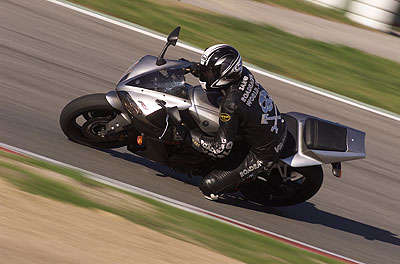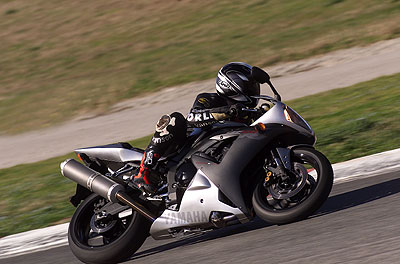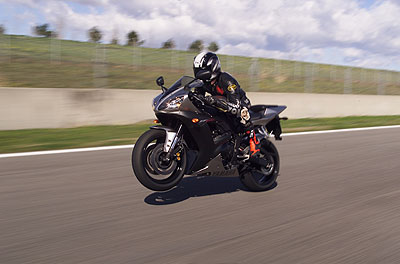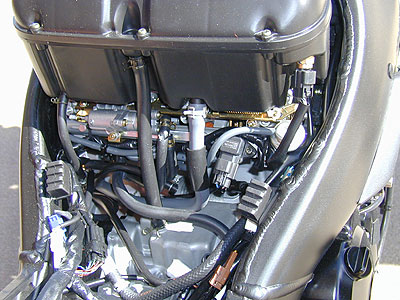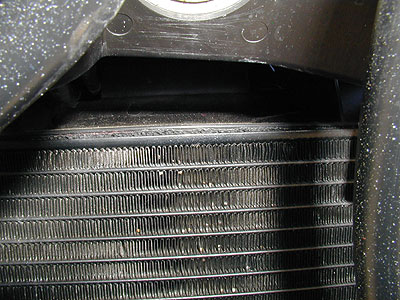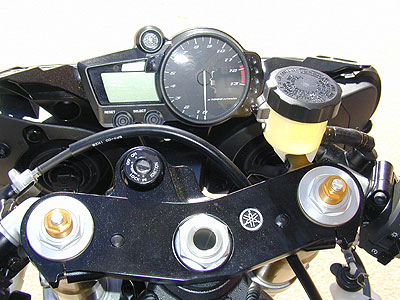2002 R1
 A Spanish mountain road, an empty pull out and thou.
A Spanish mountain road, an empty pull out and thou.
A couple weeks ago I was having dinner with a group of motorcycle enthusiasts after a hard day of dirt bike training. During the discussion of various upcoming motorcycle oriented weekend one of the attendants remarked that he had recently had his immaculate red Ducati 916 repainted gloss black. After the initial shock wore off around the table, he hit us with the second hit of the combination. He was thinking about trading in the 916 to get one of the new Silver and Black R1s. He had seen the two page ads in RW and desire had been gnawing away at him.
After years of ridiculous colors combinations that would embarrass a tub of ice cream at a Baskin-Robbins, the time honored Bold New Graphics engineering finally pays off. The R1, with its’ new frame demurely blacked out, has hit a home run with its’ delectable styling.
It is a sportbike that looks like a serious piece of hardware. It is a marine edition stainless steel and graphite Mossberg pump shotgun, not a plastic super soaker. A bike that exudes “probable cause” before the key even hits the ignition.
Now in its fifth year, the R1 has always been a serious piece of hardware and has always been the best looking heavyweight. Last year the GSXR 1000’s 165 bhp resolutely knocked the R1 firmly out of the heavy weight superstock arena and off of podiums world wide but that hasn’t stopped it from being a great street bike.
Yamaha thoughtfully released this color scheme
to coordinate with Sam's RW leathers.
The Yamaha design criteria for the 2002 R1 is a remarkable departure from the usual cold war of motorcycle development. Heavyweights are usually all about the motor. Big horsepower numbers. Rather than respond to the GSXR 1000 stunning top end, Yamaha focused on the handling of the R1, attacking at the GSXR’s only semblance of a weakness.
Heavyweights impersonating a middleweight.
The new R1 is all about style and handling with the horsepower victory being ceded to Suzuki, at least for the time being. The Yamaha engine revisions have not boosted peak horsepower significantly (claimed 2 peak horsepower) but have provided for a greater spread of power on the over-rev.
The Yamaha probably has the potential to handle better than the GSXR but mostly likely the difference will not be able to compensate for the HP spread and, given equal riders, in a dash from the last turn to the finish line the GSXR 1000 will win the race in any superstock class. In an unlimited class where the R1 engine can be modified to produce competitive horsepower, the carefully crafted Yamaha chassis might provide a competitive advantage. That will basically only benefit a single team in the US: Graves Motorsports in Formula Extreme AMA racing.
Given that Yamaha has basically ceded the racetrack to Suzuki for the next year (at least) some of the other changes that Yahama made for this year might seem like odd choices. Lower bars, less steering lock, higher footpegs, all of these things firmly indicate that Yamaha still intends the R1 to be a hard core tarmac scratching motorcycle, just one that is now more focused on the canyon crowd rather than the track crowd. On the street there are very few times when a difference between 152 and 165 bhp will be noticeable. There is still sizeable contingency money available for the tuning fork loyalists but a review of 2001 Heavyweight results suggest that the R1 riders will continue to be fighting an uphill battle.
152 bhp makes for light steering exiting corners.
Many of the improvements to the R1 are in direct response to input from racers and customers. The new Yamaha has a bolt-on subframe (with single use aluminum bolts no less!), a much more rigid chassis and revise engine placement and steering geometry to facilitate turn-in to apex. Refinements to the various engine control systems (from the intake tract to the air box snorkel and from the exhaust valves to the EXUP) are focuses at enhancing the experience of the motorcycle from the apex to the curbing.
A little more trail coupled with a higher engine makes
the R1 an apex magnate despite inappropriate track tires.
Yamaha went to great care to build an extremely capable motorcycle chassis, but on a very windy day on the Spanish Catalunya circuit, the limit was easily determined by the new Dunlop D208 tires. On a racetrack with long sweeping turns and fast entrances and exits, the front end of the bike was limited by the tire and the rear was easily overwhelmed by the legendary EXUP torque. Street tires are never meant for race tracks and it would be unfair to review a motorcycle’s race track capabilities based on inadequate traction, traction that proved to be ample on the road test portion of the launch. What follows below is, therefore, the characteristics of the motorcycle that seemed to be lurking underneath a veil of hard dry tires.
New Titainium Header pipe with dual EXUP.
Flat radiators require more surface area. This one has a lot of it.
The standard issue Yamaha suspension set-up is:
• Front (from full in)
• Rebound 13
• Compression 13
• Preload 6
• Rear
• Rebound 15
• Preload 4
• Compression 15
This resulted in having (with a 160 lbs rider) 40mm of sag in the front and 30 in the rear. These sag numbers, coupled with the static sag of 28 front and 7mm rear, suggest that the rear spring rate is about right but the front springs are still a tad weedy. The tires had 36 psi in them as recommended by the Dunlop engineers on site. Catalunya has many fast sweeping turns, a number of places that require hard braking but only one place which requires a fast change of direction from full right to full left. Yamaha’s chassis and engine revisions were done with just such a riding environment in mind. Raising the motor and increasing trail should encourage a bike to turn in quickly and then hold the selected line naturally without continuous correction from the rider. The trade off for raising the center of gravity is that it makes it harder to pick the bike up off of one knee and throw it onto the other knee.
The single combination on the track which would require such antics was also one of the only left turns. Requiring use of the cold side of the tire, this turn was the site of the days only scratched body panels and encouraged discretion rather than aggressive testing of the Yamaha’s ability to rapidly switch from full right to full left. On the tight and curvy roads of coastal Spain, the bike did not seem to resist repeated full commit right to full commit left transitions. This suggests that raising the motor in the frame was a successful revision although only a race at Texas World Speedway in August will we be able to know for certain.
The other dramatic change to the R1 Chassis set up is the increase in trail. Trail provides much of the restoring force when steering. The trail increase was done to settle the R1 in the turn faster, require fewer corrections mid-corner and allow the rider to tap into the well regulated and ample power of the engine. This would be ideal for the long long sweepers of Catalunya and the effect is probably best illustrate by two factors: gusty wind which would blow the bike off line (and, in one case, topple a slow speed maneuvering rider) and a tire which was not suited to the task. Despite reduced traction on the front end (from the tire) and gusting winds, the R1 tended to track on line without constant pressure and correction. The neutral and stable steering was a welcome time to relax my grip on the bars to let my right forearm recover from the braking effort.
The brakes obviously have a huge amount of potential, however, either Yamaha choose a very un-intimidating brake pad material (read: “weak”), my particular example had glazed brake pads, or some combination of the two. Although the brakes were fine trailing into corners on the road and other spirited street riding, on the race track they required a huge amount of lever effort to get the bike slowed down from the sort of speeds that 152 bhp and an long straight fed by a third gear corner generate. I am confident that a pad swap to a sassier compound would alleviate all of those woes.
After a few sessions to learn the track we took a stab at improving the suspension settings. The fork springs are stiffer than in the past, but would still be considered too soft by most aftermarket front end people. However, I was reluctant to wind in pre-load as that would raise the front end and slow the steering since I had no way to raise the rear ride height without adding preload and rear traction was already at a premium. I added five click of rebound (to 8 from full on) to quiet down the fork movement, added three clicks of compression to the back ( to 12) and dropped the tire pressures to 33 front and 34 rear. These changes improved the handling of the bike but the tires remained the limiting factor of the day. We were using up the tires at a rate of a set of tires every two track sessions, or about an hour of riding.
Although the tires could not allow the bike to demonstrate it’s potential, they did illustrate the bike’s fundamental strengths. The feedback through the extremely rigid chassis (from the handlebars to the rear axle) was ample and accurate and the very well mannered power plant allowed for long controlled drifts. Only occasionally would these drifts turn into straight gut wrenching heart stopping slides but, given the conditions, the fact that no one ultimately high-sided is a testament to how well the R1 allows the rider to meter the, no longer class leading, but nevertheless abundant, horsepower.
The throttle response on the track was excellent. It seems that most marquees require a couple of tries before releasing a successfully fuel injected bike that does not suffer from sniggling on/of throttle response problems. The R1’s unique approach to the problem of regulating intake tract speed air flow is a complete success. On the track the connection between throttle and power was almost electric. On the road there was the slightest hesitation from off to on but it had more to do with the amount of power available coupled with normal motorcycle drive train lash.
What would seem like a departure from the more street focus is the lower bars and higher pegs. Of course, I, like most other sport bike enthusiasts, love low bars and high pegs so I think this is just another step in the right direction. Unfortunately, the lower bars required the loss of three degrees of steering lock on both sides. While this is not a problem when you are in familiar territory, it makes course changes trickier when lost in Spain. In many cases it was easier to U-turn the bike tapping into the R1 strength, the horsepower, by just spinning up the rear tire and gently pushing one way or the other. On a smaller note, the pegs, although heavily textured, could be ever more toothy and the rear brake master cylinder was causing a slight interference with my right boot when I would try to reposition my foot to hang off to the right. Depending on your style of riding you might never notice this.
Not only is the R1 extremely adept at what you would expect, such as wheelies, burnouts, covering distance is a very short period of time and looking great while cruising the beach, it is was also very well mannered at some sorts of riding that you would not normally associate with a heavy sport bike. The R1, with its expansive powerband, nimble steering, light weight and excellent engine control system, was pure pleasure in ultra tight winding mountain roads. Sticking it in second gear and let the torque pull you from 4,000 rpm to redline while gracefully carving left to right. The R1 still has the handling of a middleweight, the torque of a truck and the looks of an exotic.
Although a fundamentally different experience than the Ducati, the compelling styling has greatly closed the fashion gap and it might just be time for my friend to trade in his Italian character for some Japanese performance.
Underneath the Beautiful Paint
Traditionally the Japanese have a four year development cycle on their flag ship models. This was expected to be the major revamp of the R1, and, although the revisions are quite comprehensive, the overall impression is that this is another iteration of the bike originally introduced five years ago. Chassis revisions, no matter how substantial, still fail to capture the imagination the way a new engine delights. All told the R1 has gained two horsepower and lost three pounds.
The 2002 R1 does enjoy some engine tweaks aimed at improving drive off of the corners and post peak spread of horsepower. Changes to the power producing end of the motor include shortening the intact tract length by 30mm (better for high revs), changing the specification on the spark plugs to an expensive iridium alloy, lightening the exhaust valves slightly (2 grams) and adding a notch to the exhaust cam to allow for cylinder specific identification for the engine control system.
A graphic illustration of all the benefits of having
exhaust valves that are 2 grams lighter.
The rest of the power modifications are related to the fuel injection, the air box and the new EXUP system.
Aluminum engine oil-coolant heat exchanger, dual EXUP and the Ti header.
The fuel injection throttle bodies incorporate CV style slides to maintain a constant velocity of the intake air charge. These throttle bodies allow for carburetor feel on a fuel injected bike. This is a different approach from Honda and Suzuki who control the air flow with the means of servo controlled flaps or butterflies. The throttle bodies are 40mm, the fuel pump is contained in the fuel tank (which has decreased fuel capacity to 17 liters from 18) and the FI system has self-monitoring features which report errors through the instrument panel.
Lurking underneath the plumbing is an ingeniously simple
solution to the fuel injection throttle control question.
The air box has been revised to allow for a new viscous style air filter and a forward facing air intake snorkel. Demurely placed above the radiator ala the YZF 750 superbike, it drops the temperature of the intake air by nine degree Fahrenheit.
Lurking past the lower triple tree and above the radiator is the new inlet
location for the airbox. Reminescent of the YZF 750 superbike set-up
but with a reduce area.
The exhaust has seen similar improvements with a new all titanium header pipe and a new dual EXUP system which features faster response, less weight (500 grams), quieter action (the flaps are now spring dampened) and, best of all is self adjusting. The motor has been relocated to near the lower shock mount. The muffle now features an integral catalytic converter (sampling the air quality in Spain will make a clean air fanatic out of anyone) but Suzuki is still showing the way forward in terms of introducing oxygenated air into the exhaust stream to reduce pollution. The R1 has an external valve and a tangle of hoses cluttering up the front of the engine which compares unfavorably with the GSXR’s tidy and elegant internal solution.
The engine has a number of other detailed revisions including a change in the torque specification on the connecting rod bolts to angle tightening, a new cylinder coating and related piston ring specification change. The shift cam has been shot peened with tin to reduce friction on the selector fork pins. The oil pan has been enlarged to increase oil capacity 200cc and the oil-coolant heat exchanger has been increased 25% from four to five rows. The low oil warning light logic has been revised to reduce false alerts.
The big news is in the chassis but conspicuous in its absence is reference to the R7. The R1’s Deltabox III has a bolt on sub-frame with single use aluminum bolts. Despite being 600 grams lighter than its predecessor it is a whopping 30% stiffer. Presumably some of the gains are in more expensive construction techniques. The 2002 has large increases in the cast sections of its frame compared to the 2001 and the spar thickness has been increased from 3.0mm to 3.5mm. The engine has been raised 20mm in the frame to raise the center of gravity. As discussed above, this make the bike turn in faster and can contribute to mid-corner stability at the price of ease of fast left to right transitions. The swingarm pivot point has been raised 17.5mm compensate for the higher engine mounting position. The frame receives a thoroughly tasteful coasting of satin black paint.
On the back end the 2002 gets a new asymmetrical swingarm with the right side higher than the left to allow for tighter fitment of the exhaust pipe. The spring rate has been increase 10% to a more real world rate of 88.3 N/mm (500 pounds). The rear shock was lightened mildly by substituting some aluminum for some previously ferrous parts. The lever ratios remain static despite different parts related to the new frame.
The front suspension receives a more thorough update. New triple trees reduce offset to add an additional 10mm of trail to the chassis. The fork tube diameter has been increase from 41mm to 43mm while the fork tube thickness has been reduced from 2mm to 1.75mm in the interest of saving weight. After telling the world for years that the R1 needs extra fork travel to keep the front wheel in contact with the ground during hard acceleration, they have now reduced fork travel to an industry standard 120mm. The range of adjustments have been increased and the fork springs have been stiffened from 7.35 N/mm to 8.34 N/mm. Aggressive riders will probably want to swap those out for 9.0 to 9.5 rate springs depending on rider weight and intended terrain. The front end get a slightly easier task by sporting lighter front Sumitomo calipers that drop 5% of their weight by adopting aluminum pistons.
No more blue caliper plugs. The gold ones indicate the aluminum pistons.
Both the front and rear wheels have been lightened slightly. The front by 96 grams, the rear by 176 grams.
The rider gets to enjoy all of these revisions through repositioned controls. The forged clip-ons (stiffer) are 10mm further forward while the pegs are 17.5mm higher and 12mm further back. The lower bars required the steering lock to be reduced by 3 degrees on both sides.
Pushing on the left forged clip-on.
The 2002 gets a few electrical upgrades including a more powerful charging system (presumably required to power the fuel injection) increased from 365 watts to 490 watts. The instrument panel feature all the usual stuff, a clock, an analog tach, a digital speedo, a programmable shift light and adjustable back lighting.
A pleasing font on the analog tach and adjustable back lighting on
the LCD display, the programmable shift light completes the cluster.
Some of the street styling includes a pretty painted modesty panel under the tail section, an clear LED taillight assembly (which, despite the ample power now supplied by the new charging system, uses 80% less power than a standard bulb taillight). The 2002 gets swoopier turn signals and is available in blue, red/white and, most relevantly, the stunning silver and black. Suggested retail is unchanged at $10,300.
Delightfully finished tail section.
Look ma, no bulbs.
Only the red and white one comes with a color coordinated tire wall.
Photos by David Dewhurst and AOD-MOI

